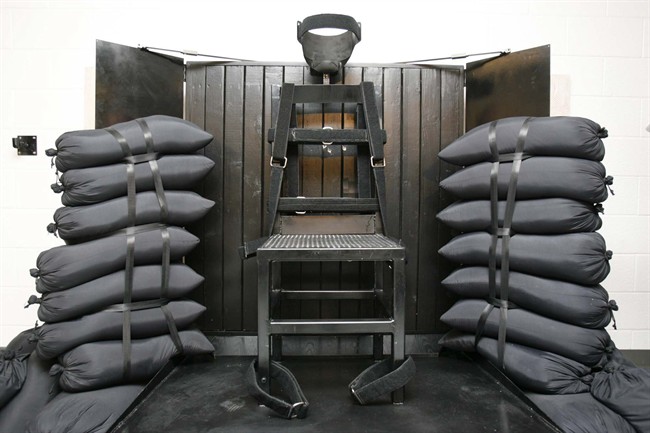SALT LAKE CITY – Utah Gov. Gary Herbert has given his stamp of approval to a law that brings back the firing squad in the only state that has used it in the past 40 years.

Under the measure approved Monday, firing squads will serve as a backup method if lethal injection drugs aren’t available. Here’s a closer look at how it works:
WHAT HAPPENS ON EXECUTION DAY?
The prisoner is seated in a chair that is set up in front of a wood panel and in between stacked sandbags that keep the bullets from ricocheting around the room.
A target is pinned over the inmate’s heart. Shooters aim for the chest rather than the head because it’s a bigger target and usually allows for a faster death, said Utah Rep. Paul Ray, who sponsored the proposal.
Watch Below: Utah votes to bring back firing squads
The prisoner is offered a two-minute window to offer final words. In 1977, Gary Gilmore used that chance to say, “Let’s do this,” before he died.
Five shooters set up about 25 feet (8 metres) from the chair, with their .30-calibre Winchester rifles pointing through slots in a wall. Assuming they hit their target, the heart ruptures and the prisoner dies quickly from blood loss.
In 2010, Ronnie Lee Gardner was declared dead two minutes after he was shot. He was the last person killed by firing squad in the U.S.
WHO ARE THE SHOOTERS?
The gunmen are chosen from a pool of volunteer officers, with priority given to those from the area where the crime happened.
There are always more volunteers than spots on the squad, Ray has said.
The shooters’ identities are kept anonymous, and one of their rifles is loaded with a blank round so nobody knows which officer killed the inmate.
HAVE FIRING SQUAD EXECUTIONS EVER GONE WRONG?
Not in recent history, said Deborah Denno, a Fordham Law School professor who has long studied executions. Utah’s three firing squad executions in the past four decades went as planned, she said.
But the Washington, D.C.-based Death Penalty Information Center, which opposes capital punishment, warns that a firing squad is not a foolproof execution method because the inmate could move or the shooters could miss the heart, causing a slower, more painful death.
One such case appears to have happened in 1879, during Utah’s territorial days, when a firing squad missed Wallace Wilkerson’s heart and it took him 27 minutes to die, according to newspaper accounts.
Denno said errant shots to Wilkerson’s shoulder might have been intentional to make him suffer.
CAN ORGANS BE DONATED AFTER FIRING SQUAD EXECUTIONS?
Yes. Unlike a lethal injection that poisons the organs, the bodies of people executed by firing squad remain usable.
Gilmore, executed by firing squad in 1977, agreed to donate his eyes, kidneys, liver and pituitary gland for medical use. His kidneys proved unusable because of bullet wounds.
Gardner did not donate his organs.
ARE ANY UTAH INMATES IN LINE FOR THE FIRING SQUAD?
Yes. Ron Lafferty, who claimed God directed him to kill his sister-in-law and her baby daughter in 1984 because of the victim’s resistance to his beliefs in polygamy, has requested the firing squad.
- 2 teens charged with murder in case of 16-year-old killed outside Halifax mall
- Green Party deputy leader given jail sentence for Fairy Creek old growth protests
- Cars torched, explosions heard in suspected arson in Montreal neighbourhood
- Gas station clerk stabbed several times during violent attack at Ultramar in Montreal
Lawmakers in the state stopped offering inmates that choice in 2004, saying firing squads attracted intense media interest and took attention from victims. But Lafferty got the option because he was convicted before 2004.
The other Utah death row inmate who could be next up for execution, Doug Carter, has chosen lethal injection. Under the new law, Carter would die by firing squad if the state can’t get lethal injection drugs 30 days before his execution date.
DO ANY OTHER STATES USE FIRING SQUADS?
The firing squad is on the books in Oklahoma, but the chances it will be used there anytime soon are much more remote than in Utah.
Under Oklahoma law, the firing squad already is the third option for executions, to be used only if the courts rule that the first two choices – lethal injection and electrocution – are unconstitutional.
The firing squad would become even less likely in Oklahoma if lawmakers approve a bill authorizing nitrogen gas as an execution method. Under that proposal, nitrogen would become the second option if lethal injection drugs are unavailable, bumping the firing squad to No. 4.


Comments